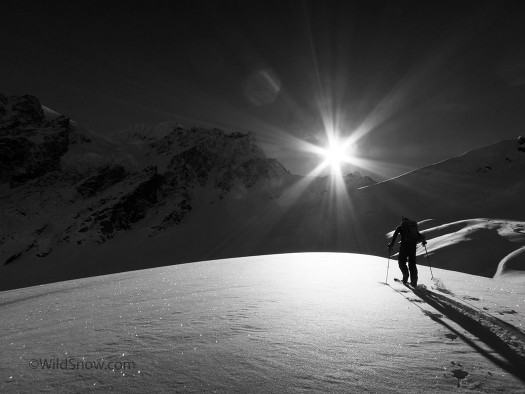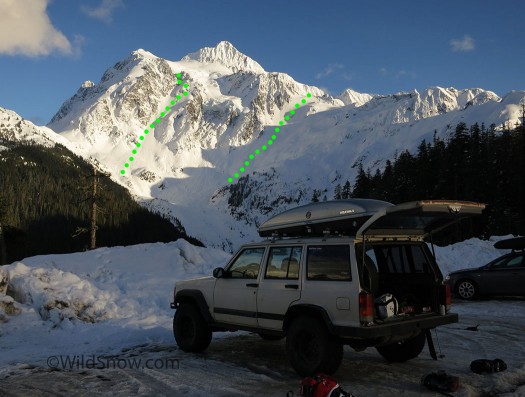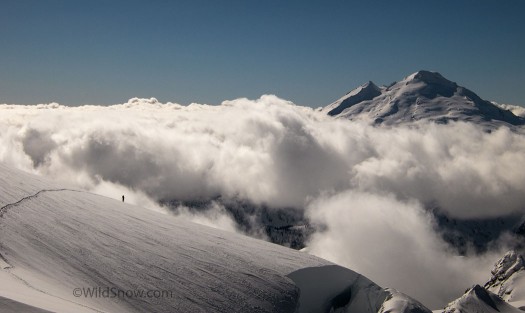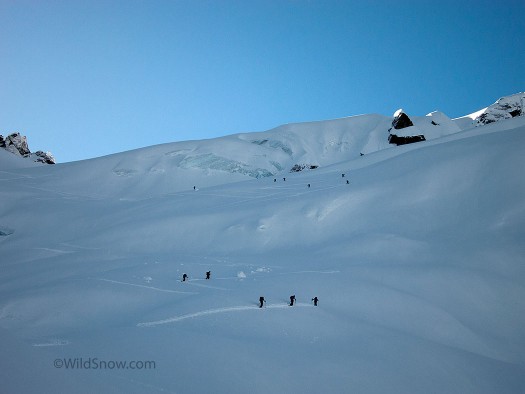
Peter finds the first sunlight of the day, tromping through light, sparkly powder on Mount Shuksan, Washington.
Last weekend was a reminder of how lucky I am to be living and going to school in this far corner of the States. For all the rain and gloppy pow, it is days like this that make it incredible. Taking advantage of a spurt of sunny weather, I was able to play in powder on the flanks of the ever-impressive Mt. Shuksan.
Shuksan is an incredible piece of rock and ice. It would be a destination anywhere in the world, but the fact this mountain is connected to civilization by the thread of Hwy 542 makes it unique. I have hundreds of Shuksan photos on my computer, all from different days, all basically identical, but I can’t bring myself to delete any of them. Perhaps the coolest part is that while the north and south sides of Shuksan are visible and relatively accessible, the eastern flanks are deep in the wilderness of the Cascades. It blows me away that there are entire glaciers, an entire half of this mountain, that I haven’t even seen.
With thoughts like these bouncing around my head, skiing Shuksan is always in the back of my mind, especially when any wisp of good weather blows in from the Pacific. Shuksan, for all her ease of access, isn’t easy mountaineering. All routes involve approaches, avalanche danger, and various other defenses. The prevailing wind has a nasty propensity to load the tasty ski routes on the north side. Over my short time in the area, I’ve attempted the mountain about 15 times. With that effort, I’ve stood on top exactly once, and skied a small handful of routes.
Of course in some ways it’s frustrating to have been up there so much and have done so little, and it’d be great to have memories of 10 or 15 summits. However, perhaps it’s important to have a certain ratio of failures in a mountaineering career. I’d hope that dismal success rate points to a mindset of caution and safety, but more likely a good part of this is brought on by my own ignorance and idiocy. Learning curve.
My first Shuksan trip involved utterly failing to find the approach trail on a foggy, rainy day on the easy south side route. More recently, our group witnessed a massive avalanche cut out of the northwest couloir, as we climbed the rapidly wind loading White Salmon Glacier. We quickly called it a day.

Mt. Shuksan, from the Mt. Baker Ski Area parking lot. The Northwest couloir is on the left, while the White Salmon Glacier is on the right.
Browsing the weather and avalanche forecasts in class last week (don’t tell), I had high hopes for ideal conditions on the enticing north side. The rain event during the past weekend stabilized the lower snowpack, which also appeared to be bonding well with the recent storm snow. Last Friday, Adam and I left Bellingham at the leisurely hour of 6, and met Peter in the deserted ski area parking lot. We found surprisingly good snow on the approach descent, made our way up the valley, and began the climb toward the White Salmon Glacier. The valley is somehow perpetually filled with massive, fresh avalanche debris, an impressive, spooky reminder of the tons of snow that accumulate over the winter.
As we climbed the White Salmon, we found perfect, light powder, and the rain crust eventually disappeared. As we climbed, we were treated to several impressive serac falls from the Hanging Glacier. Going against all instincts, we climbed on, toward the thundering display of destruction. Although exciting, the route we followed is close, but never in direct danger from the “Hanging Glacier” glacier.

I didn't catch any of the bigger serac falls on my camera, but this "small" one is still pretty humbling. That face is about 3,000 feet high.

Curtis Headwall, skied by Dan Helmstadter about a year ago. It looks this steep and gnarly from just about every angle. Impressive.
The snow quality only improved as we climbed onto the upper Curtis Glacier, and made our way toward the entrance to the Northwest Couloir. Bluebird, warm, and the snow was blower, without a hint of wind-effect, I was stoked!
At the top Peter gave his boss a call to let him know he would definitely be a little late for work, and we dropped in. The first turns were everything I had hoped for. We made our way down toward the narrow, traversy entrance to the couloir. The snow in the narrow bit was not as deep, and didn’t sluff as much as we skied. After making my way over the exposed traverse, I found myself looking down several thousand feet of steep, untouched snow. I was excited. I had climbed the Northwest Couloir once, several years ago, but turned around just below here, due to a thickening windslab. I paused for a moment, and then made my first turns. Blower!
The light snow created one of the biggest sluffs I’ve experienced. I worked each turn a bit further over, and then waited for the cascade to go by, before doing the same the other direction. With the snow billowing overhead, and the wide sluff thundering down beside, I couldn’t help but hoot and holler. I haven’t skied snow like that in the Northwest all year. It was a treat. The rest of the couloir skied just as good, and the snow got less sluffy down low. Even the lower valley had a bit of corn on sunny slopes.
At the base grins and high-fives abounded, and we made our way back to the bottom of the valley, then climbed to the parking lot.
I briefly entertained thoughts of doing my homework the next day, but opted to irresponsibly treat my self again. Kirk and I left slightly earlier than the day before, and decided to climb the same route, and see what looked like good skiing. The few weekends every year that Shuksan holds sunny, soft snow tend to bring quite a few people to the mountain, especially in recent years. After having the mountain to ourselves on the incredible day before, I didn’t mind other guests. Indeed, I find happiness in enjoying a mountain with other excited, like-minded people.
The day was even more clear than the previous, although I observed telltale wisps of windblown snow on the high ridges. We made our way up the White Salmon Glacier, and we indeed encountered a bit more wind-affected snow than the day before. At the top of the glacier we decided to ski down and check out the White Salmon Headwall, a steep, narrow couloir nestled between the White Salmon and Hanging glaciers.
I went first, and within the first few turns I cut out a shallow, wide, wind slab, perhaps 6 inches deep. Being above the slab at the top of the run, I was safe, however the slide gathered a fair amount of snow by the time it made it to the bottom. Though we were pretty sure this was an isolated pocket at the top of the run, to be safe we decided to ski the cleaned-out path and see what the snow was like farther down. Alas, the wind had done it’s work all the way down, including the base to the intimidating White Salmon Headwall. Not wanting bring anything down on top of us, we abandoned our plans and skied the slide runnout down to the valley floor. The slide debris skied surprisingly well. At the base we skinned back up to meet our uptrack, and then skied down into the valley.
We made it back to the car quite early. The warm, spring day at the ski area was busy — tailgate chips and salsa were perfect. After a welcome break before stressful finals week, I should probably get back to work.
Louie Dawson earned his Bachelor Degree in Industrial Design from Western Washington University in 2014. When he’s not skiing Mount Baker or somewhere equally as snowy, he’s thinking about new products to make ski mountaineering more fun and safe.





